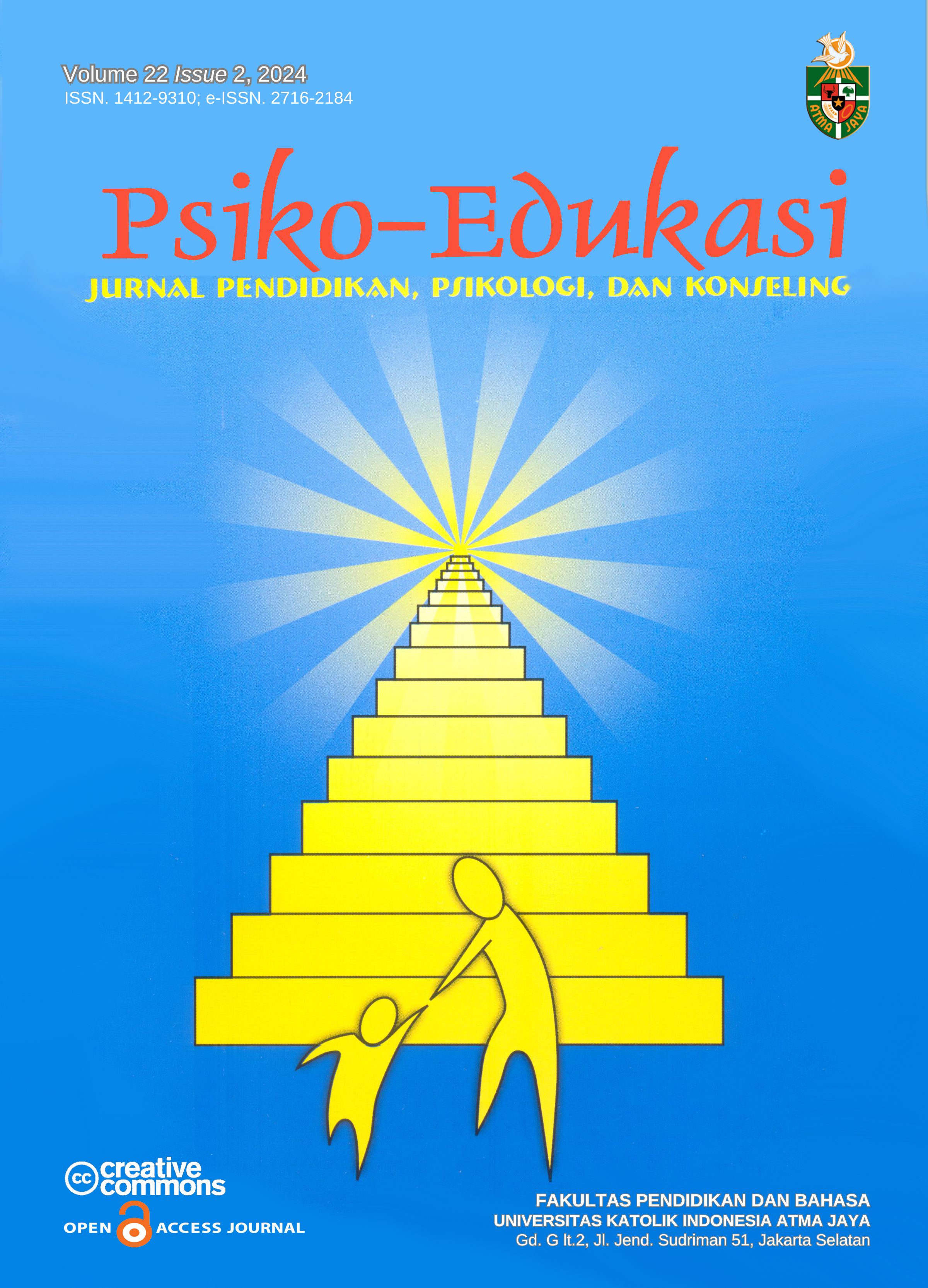THE ROLE OF GUIDANCE AND COUNSELING TEACHERS IN DEVELOPING ORAL COMMUNICATION OF STUDENTS WITH DEAF DISABILITIES AT SMPLB TUNARUDU PANGUDI LUHUR, WEST JAKARTA
DOI:
https://doi.org/10.25170/psikoedukasi.v22i2.6149Keywords:
The role of guidance and counseling teachers, developing oral communication, students with hearing disabilitiesAbstract
Researchers discovered a phenomenon regarding the obstacles faced by guidance counselors in communicating orally with hearing-impaired students when interacting with them, including when the guidance counselor provides counseling services. The purpose of this research is to identify the obstacles faced by Guidance and Counseling teachers in communicating orally with hearing-impaired students and to understand the role of Guidance and Counseling teachers in developing an oral communication system for hearing-impaired students. This research was conducted at SMPLB Tunarungu Pangudi Luhur Jakarta Barat. Data collection was conducted through interviews, observations, questionnaires, and documentation. The analysis of the research data uses data triangulation. The research findings regarding the obstacles faced by guidance counselors are the ability of the guidance counselor to understand the messages conveyed by hearing-impaired students and the difficulty in conveying ideas and concepts to hearing-impaired students. The results regarding the role of guidance and counseling teachers in developing oral communication include getting hearing-impaired students to repeat their speech with clear articulation and voice, providing access to oral communication, correcting speech errors with proper language patterns, giving speech reading exercises, being open to students, being patient and empathetic, and providing positive reinforcement. The role of the Guidance and Counseling teacher as a facilitator, mediator, and demonstrator helps develop oral communication according to the needs of hearing-impaired students. Advice to parents is that cooperation with the school is expected. Advice to the guidance counselor regarding the role of the guidance counselor in developing oral communication in hearing-impaired students is to get them accustomed to communicating orally clearly and to provide oral communication training during counseling sessions, in addition to the need for cooperation with school staff to maximize the development of oral communication in hearing-impaired students. Advice to the head of SMPLB is to provide structured and programmed oral communication training services to students with hearing disabilities. Advice to the BK program, especially in the deepening of the Inclusive Education course, is expected to include learning and discussions on the role of BK teachers in developing oral communication for hearing-impaired students.
References
Angelia Widyastuti, P., & Widiana, I. W. (2020). Analisis Peran Tutor Sebaya Terhadap Sikap Sosial Siswa Tuna Rungu. Journal of Education Technology, 4(1), 46–51. Diakses dari https://doi.org/10.23887/jet.v4i1.24083.
Ayulianti, B., H.R & N.M. (2021). Metode Pembelajaran Dalam Mengembangkan Interaksi Sosial. Jurnal Literasi Pendidikan Dasar, 2(1), 23-30. Diakses dari https://media.neliti.com/media/publications/408782-metode-pembelajaran-dalam-mengembangkan-05c732ea.pdf
Bintoro, Totok. (2010). Kemampuan Komunikasi Anak Tunarungu. Perspektif Ilmu Pendidikan, 22. Diakses dari https://media.neliti.com/media/publications/259570-kemampuan-komunikasi-anak-tunarungu-20f1f6b0.pdf
Deis Sepriani. (2010) Pengembangan Komunikasi Verbal Pada Anak Tunarungu. Jurnal Asesmen Dan Intervensi Anak Berkebutuhan Khusus, 10(2), 124. Diakses dari https://ejournal.upi.edu/index.php/jassi/article/view/3916/2798
Dowaliby, F.J., Burke, N.E., & Mckee, B.G. (1983). A Comparison of Hearing-Impaired And Normal Hearing Students Locus Of Control, People Orientation, And Study Habits And Attitudes. American Annals of the Deaf, 128(1). Diakses dari https://bit.ly/JSTORJournal3DfSj1J
Duarte, I., Santos, C.C., Rego, G., & Nunes, R. (2016). School Failure in Students Who Are Normal-Hearing or Deaf: With Or Without Cochlear Implants. SpringerPlus 5, 237. Diakses dari https://doi.org/10.1186/s40064-016-1927-9
Hernawati, Tati. (2007). Pengembangan Kemampuan Berbahasa dan Berbicara Anak Tunarungu. Jurnal Universitas Pendidikan Indonesia, 7(1). Diakses dari http://file.upi.edu/Direktori/FIP/JUR._PEND._LUAR_BIASA/196302081987032-TATI_HERNAWATI/jurnal.pdf
Lemke, Ulrike & Scherpiet, S. (2015). Oral Communication in Individuals With Hearing Impairment Cnsiderations Regarding Attentional, Cognitive And Social Resources. Frontiers in psychology, 6, 998. Diakses dari https://doi.org/10.3389/fpsyg.2015.00998
Nasihudin dan Hariyadin. (2021). Pengembangan Keterampilan dalam Pembelajaran. Jurnal Pendidikan Indonesia, 2(4). Diakses dari https://doi.org/10.59141/japendi.v2i04.150
Nofiaturrahmah, F. (2018). Problematika Anak Tunarungu Dan Bagaimana Cara Mengatasinya. Quality, 6(1), 1-15. Diakses dari https://www.researchgate.net/publication/343505307_PROBLEMATIKA_ANAK_TUNARUNGU_DAN_CARA_MENGATASINYA#full-text
Nugroho, Gregorius Bambang. (2022). Asesmen dan Intervensi Pendidikan Bagi Siswa Dengan Hambatan Pendengaran. Jurnal pendidikan, psikologi, dan konseling, 20(1), 45-52. Diakses dari https://doi.org/10.25170/psikoedukasi.v20i1.3423
Permanarian, Somad dan Hernawati, Tati. (1996). Orthopedagogik Tunarungu. Jakarta: Ditjen Dikti. Diakses dari: http://library.fip.uny.ac.id/opac/index.php?p=show_detail&id=780
Rauzanna. R., Bunyamin dan Fitri. M. (2023). Kinerja Guru BK Dalam Mengatasi Kesulitan Berkomunikasi Anak Berkebutuhan Khusus Di SLB Negeri Pidie. Jurnal Psiko-Konseling, 1(1), 4-7. Diakses dari https://journal.unigha.ac.id/index.php/JPk/article/view/1235
Rezieka, Dara.G, dkk. (2021). Faktor Penyebab Anak Berkebutuhan Khusus dan Klasifikasi ABK. Jurnal Pendidikan Anak, 7(2), 41. Diakses dari https://jurnal.ar-raniry.ac.id/index.php/bunayya/article/viewFile/10424/5810
Riswani dan Diniaty, Amirah. (2008). Konsep Dasar Bimbingan dan Konseling. Pekanbaru: Suska Press.
Sadja’ah, E. (2005). Pendidikan Bahasa Bagi Anak Gangguan Mendengar. Jakarta: Departemen Pendidikan Nasional. Diakses dari: http://library.fip.uny.ac.id/opac/index.php?p=show_detail&id=2600
Saputri, A. (2017). Analisis Pola Komunikasi Pada Siswa Tunarungu Di Smalb Asih Kota Pontianak. Jurnal Pendidikan dan Pembelajaran Khatulistiwa, 6(6). Diakses dari https://jurnal.untan.ac.id/index.php/jpdpb/article/view/20321/16655
Solikhatun. Yanuar Umi. (2013). Penyesuaian Sosial Pada Penyandang Tunarungu di SLB Negeri Semarang. Educational Psychology Journal, 2(1). Diakses dari https://journal.unnes.ac.id/sju/index.php/epj/article/view/2588
Sri, Aninditya, dkk. (2021). Optimalisasi Penggunaan Bahasa Isyarat Dengan SIBI dan BISINDO Pada Mahasiswa Difabel Tunarungu Di Prodi PGMI UIN Sunan Kalijaga. Holistika: Jurnal Ilmiah PGSD, 5(1), 305. Diakses dari https://doi.org/10.24853/holistika.5.1.28-33
Sunarya, P.B., Irvan, M & Dewi, D.P. (2018). Kajian Penanganan Terhadap Anak Berkebutuhan Khusus. Jurnal Abadimas Adi Buana, 2(1), 11-19. Diakses dari https://doi.org/10.36456/abadimas.v2.i1.a1617
Wijaya, I.K. (2017). Proses Komunikasi Interpersonal Bawahan Tuna Rungu-Wicara Dengan Atasanya (Supervisor) Di Gunawangsa Hotel Manyar Surabaya, Jurnal E-Komunikasi, 7. Diakses dari: https://media.neliti.com/media/publications/185819-ID-proses-komunikasi-interpersonal-bawahan.pdf
Yasin, M.I & Apsaro, N.C., (2020). Pembinaan Orang Dengan Disabilitas Rungu Untuk Mendapatkan Pekerjaan. Prosiding Penelitian dan Pengabdian Kepada Masyarakat, 7(2). Diakses dari https://www.researchgate.net/publication/343634153_PEMBINAAN_ORANG_DENGAN_DISABILITAS_RUNGU_UNTUK_MENDAPATKAN_PEKERJAAN/fulltext/5f35398192851cd302f18015/PEMBINAAN-ORANG-DENGAN-DISABILITAS-RUNGU-UNTUK-MENDAPATKAN-PEKERJAAN.pdf


















